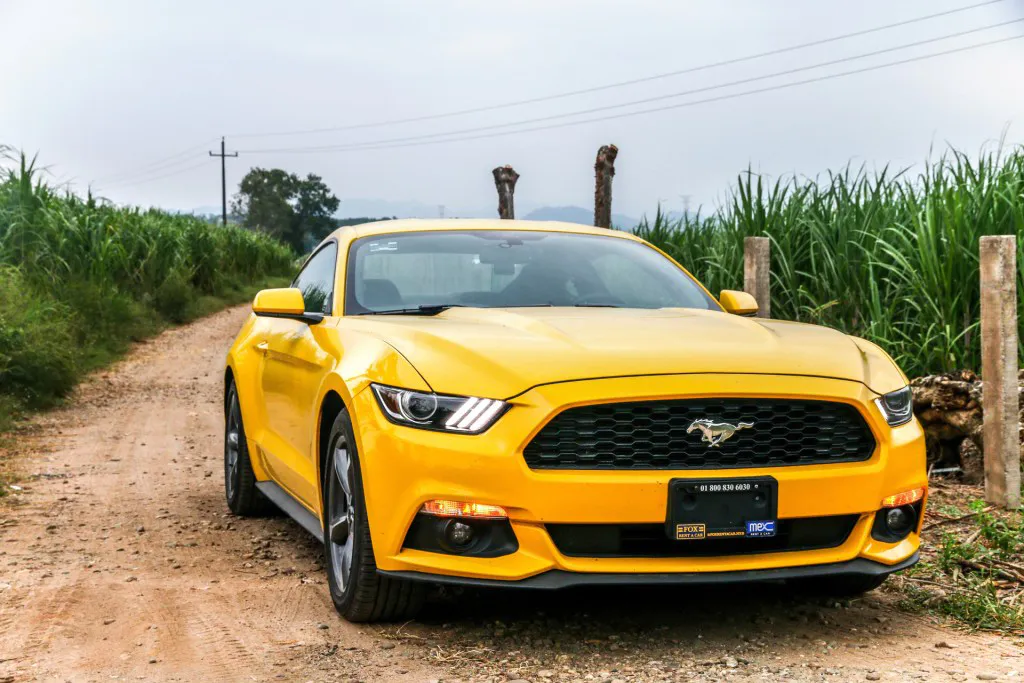There are few vehicles as iconic as the Ford Mustang. For almost 60 years, this legendary sports car has thrilled drivers across the globe. And while production for competing vehicles like the Chevrolet Camaro and Dodge Challenger has been inconsistent, Ford has continuously cranked out the Mustang. It’s a long-running nameplate.
This decades-long history means an ample supply of used Mustangs. But buying just any Mustang could be an expensive blunder. Why? Because some model years are better than others, and some versions should be avoided at all costs. Read on as we explain these differences. These details will help you select the best Ford Mustang or tell you what to expect if you already own one.
This advice comes from reviewing vital data from Ford Mustangs with an installed FIXD sensor (this produces the FIXD Reliability Score). Further, a FIXD survey of Mustang owners provides the Owner Reliability Score and insights into reliability perceptions, repair costs, problem areas, and ownership experiences.
We combine the FIXD Reliability and Owner Reliability Scores with published data covering crash tests, fuel economy, and resale value to develop Ford Mustang model year ratings.
One quick note: Sometimes, there’s not enough survey data to help us determine if a Mustang model year is good or bad. Owner feedback can be invaluable for understanding repair history, upkeep expenses, and other vital insights. We’ve assigned these Mustangs an “undecided” status in these situations. We’ll discuss the available information and let prospective buyers determine if these cars are worthwhile.
Here’s an over of the best/worst/undecided Mustang model years. The details behind these rankings are explained further on.
| Best Years | Why? | Worst Years | Why? |
| 2018-2020 |
High owner ratings, perfect crash-test scores, and low chance of expensive repairs |
2015-2016 |
First year of 6th generation (2015), lower engine reliability ratings, and high chance of expensive repairs |
| 2007 |
Strong owner rankings, moderate upkeep costs, and low likelihood of pricey repairs |
2005-2006, 2008, 2010-2014 |
First year of 5th generation (2005), poor engine reliability ratings, and elevated chance of expensive repairs |
| 2004 |
High owner ratings, reasonable upkeep expenses, and minimal chance of expensive repairs. |
2001-2003 |
Poor engine reliability scores, high upkeep costs, and increased likelihood of engine and transmission repairs |
| Undecided Years | Why? |
| 2009, 2017, 2021 |
Insufficient owner feedback |
Ford Mustang Engine Reliability Score, Safety Ratings & MPG Year by Year
Several factors go into determining the best and worst Ford Mustang model years.
- Engine reliability: the FIXD Reliability Score
- Owner Reliability Score
- NHTSA crash test ratings
- EPA-estimated fuel economy
- Annual repair and maintenance costs compared to market value
Keep reading to learn how these elements are applied.
If you’re in the market for a car, take a look at our article on the USA’s most reliable and cheapest to repair vehicles. Don’t get stuck with a lemon; use our data to help you shop.
Engine Reliability Score – Over The Years
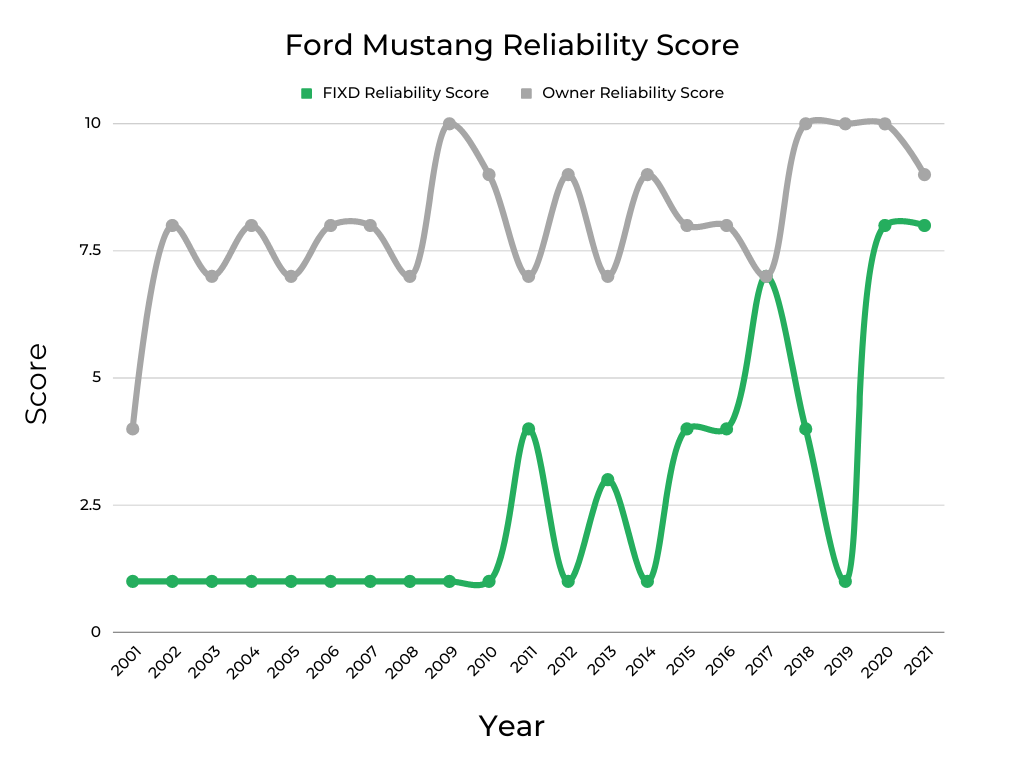
The graph shows two factors that are used to assess engine reliability:
- FIXD Reliability Score (green): This measure comes from the number of check engine lights detected in Ford Mustangs with a FIXD sensor.
- Owner Reliability Score (gray): Perceived owner reliability about their Ford Mustang determines this ranking. Owners are asked how suitable their car is for journeys of varying lengths. For example, a Mustang that’s only usable for short point A to point B trips receives the lowest rating. While a car that can handle a cross-country trip rates highest.
Both scores use a 1 (lowest) to 10 (highest) scale; 5 is average.
You’ll see a wide gap between these two scores for the Ford Mustang. This isn’t unusual, although older model years rank very low for the FIXD Reliability Score. As the chart shows, this contrasts sharply with the Owner Reliability Score for many years of the Mustang.
This difference likely comes from owners being more accepting of check engine lights, mainly, when dealing with an older car. Simply put, age and more miles equals more check engine lights.
However, looking at the FIXD Reliability Score and the Owner Reliability Score together provides clearer insight into the best or worst Mustang model years. Specifically, if the FIXD Reliability Score and Owner Reliability are both low, then that’s likely a year to avoid. Yet, just having a low FIXD Reliability Score doesn’t automatically mean a thumbs down for that particular model year. We consider other factors, such as the number of recalls, safety data, and owners’ experiences with expensive repairs. This is explained later.
Further, there’s no breakdown on which Mustang engine is more problematic. Ford does not provide sales information based on what’s under the hood. Presumably, the company sells more base-engine versions (a V6 or turbocharged four-cylinder, depending on the model year) than V8-powered Mustangs because of the lower price. However, this assumption can’t be confirmed.
Read the Ford Check Engine Light article to find the most common reason for a check engine light to appear in a Mustang and other popular Ford vehicles.
NHTSA Safety Score – Over The Years
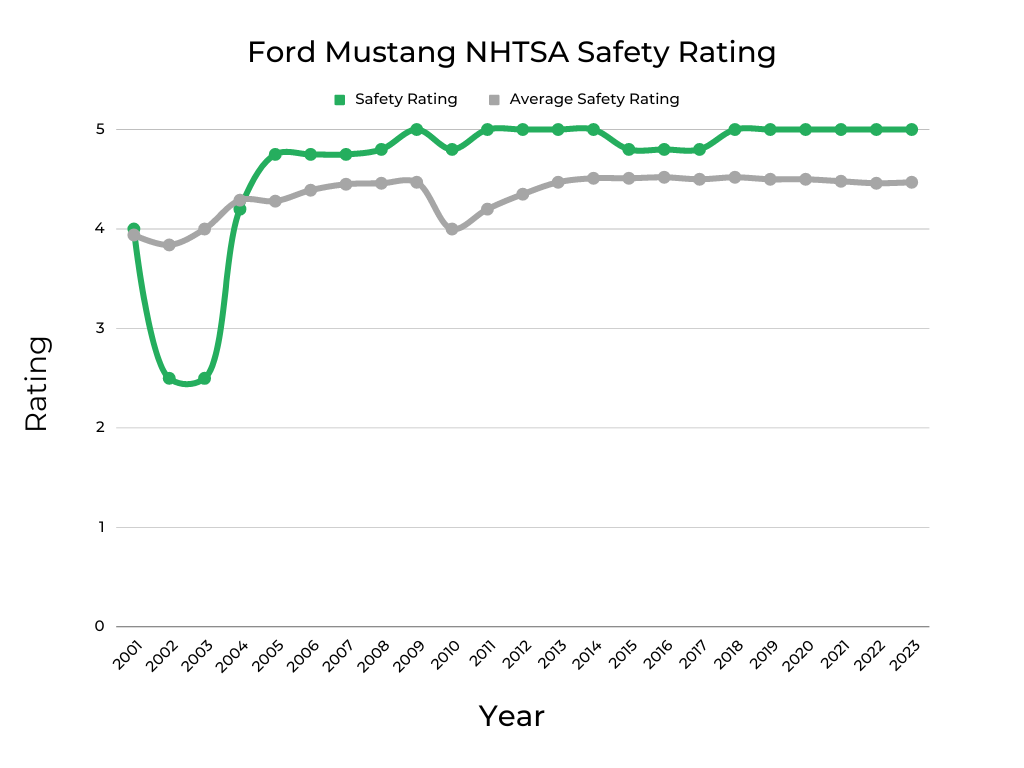
Safety is significant with any automobile, especially sports cars like the Ford Mustang. One-third of surveyed owners report using their Mustangs for sport/fast driving. While no one intends to crash, knowing this car performs better in government testing than the average vehicle in this category helps with driver and passenger confidence. This is helpful because 20% of Mustang owners use their cars for family transportation.
Except for the 2002-2003 model years, 21st-century Mustangs meet or exceed competing sports cars for safety. What’s equally impressive is that 9 out of the 21 model years we’re looking at achieved a perfect 5.0 out of 5 in National Highway Transportation Safety Administration (NHTSA) crash tests. Meanwhile, another eight Mustang editions earned a 4.8, which is still remarkable.
Stellar safety performance is standard on most modern Ford Mustangs. This is crucial in keeping insurance costs low.
If you live in one of the states listed below, we can show you the cheapest vehicles to insure in yours.
What Used Cars Are the Cheapest To Insure In:
| What Used Cars Are the Cheapest To Insure In: |
| Ohio |
| North Carolina |
| Michigan |
| Georgia |
| Texas |
| New York |
| Illinois |
| Pennsylvania |
| California |
MPG – Over The Years
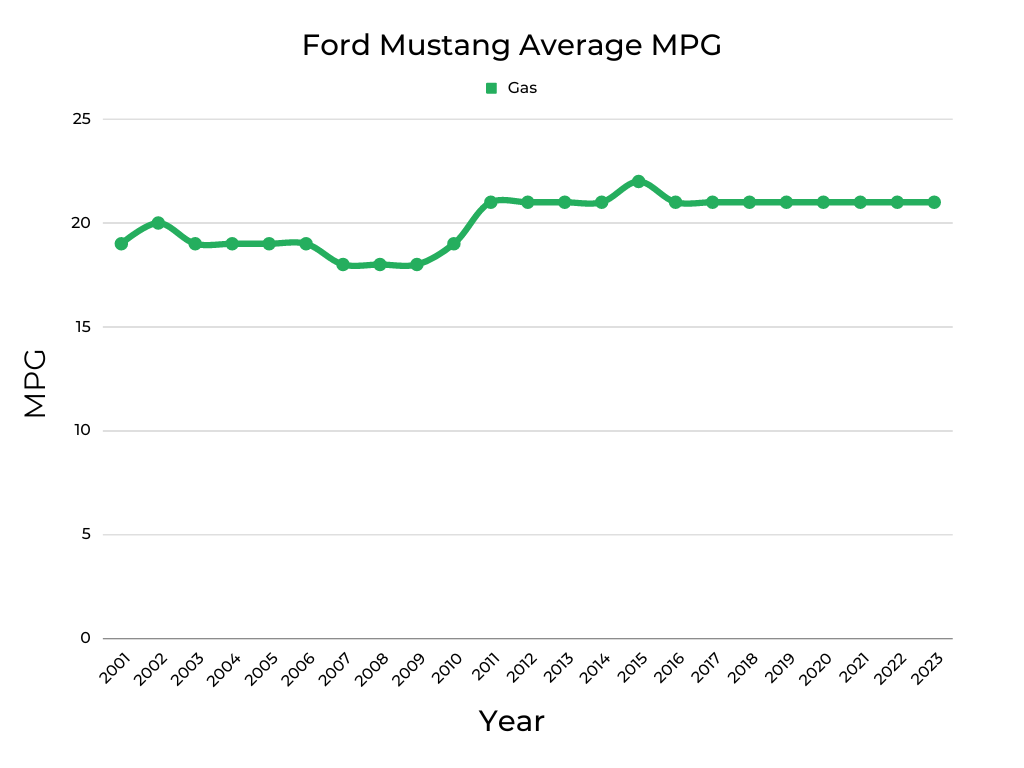
Fuel economy may not be a priority for every Mustang owner, but it’s helpful to know, especially if you’re itching to get behind the wheel of a gas-sucking V8-powered Mustang GT or Shelby Mustang.
The above chart reflects the EPA-estimated fuel economy average among all engine types for that particular model year. So if you’re thinking of getting a used Mustang with a V6 or EcoBoost (turbo four-cylinder) engine, expect to do better than this average. In contrast, a Mustang with a V8 requires more frequent fill-ups.
For the most part, a modern Mustang averages about 20 MPG. Only the 2007-2009 model years dip to 18 MPG, which is still respectable for a performance vehicle. And going back to 2011, the Mustang offered an average of 21 MPG.
Generally, the Mustang holds an edge in the fuel economy race against competitive vehicles. An improvement of 1-2 MPG may not seem like much, but that equates to a 5-10% drop in fuel use, which matters to the 24% of Mustang owners who use their cars for “lots of driving” (traveling and commuting).
| Ford Mustang | Chevy Camaro | Dodge Charger | |
| 2010 | 19 MPG | 20 MPG | 19 MPG |
| 2015 | 22 MPG | 18 MPG | 20 MPG |
| 2021 | 21 MPG | 20 MPG | 19 MPG |
Current Market Value of All Ford Mustangs Years & Cost Per Year to Repair and Maintain Each
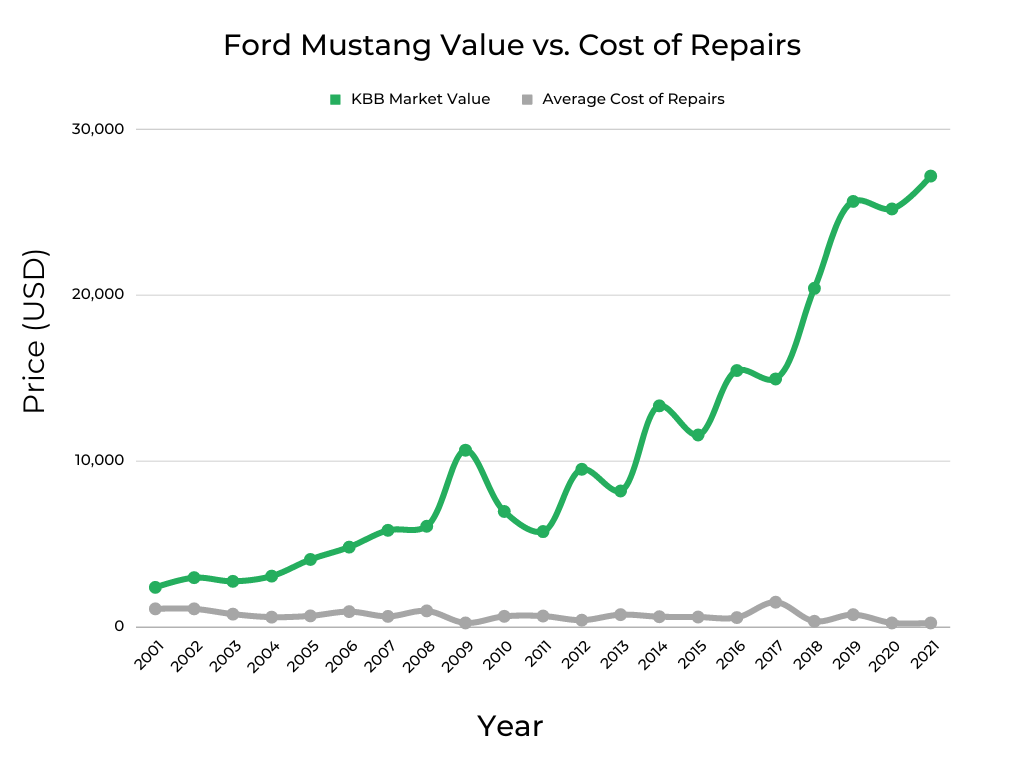
High annual upkeep costs hurt resale value. So, being watchful in this area is helpful, especially if you’re considering different Mustang model years. Fortunately, Mustangs aren’t outrageously expensive to maintain.
Among all 2001-2021 Mustangs in our survey, the average annual repair and maintenance costs are $697. That’s pretty close to the $652 the typical car owner (among all cars) spends each year, according to RepairPal.
Unsurprisingly, the most expensive Mustangs to maintain are older ones. Owners of the 2001-2002 spent an average of $1,100 over the last year to keep their cars on the road. That’s about two-thirds more costly than the average Mustang. Still, that’s the price one pays for having an older car.
On the flip side, some Mustangs are cheap to own. Like the 2012 model year, with average yearly repair and maintenance costs of $417. And it’s even less expensive for owners of 2020-2021 Mustangs, who typically spend $250 for annual upkeep. Of course, this figure is likely to rise as brake pads, tires, and other consumable parts need replacing. In addition, many of these vehicles are likely to still have a factory warranty.
It can also be useful to see how the three most recent Ford Mustang generations compare with annual repair and maintenance costs.
| Ford Mustang Generation | Years | Average Annual Upkeep |
| Fourth | 2001-2004* | $895 |
| Fifth | 2005-2014 | $704** |
| Sixth | 2015-2023^ | $612^^ |
^ 2023 is the final model year for the sixth-generation Ford Mustang
** Excludes 2009 model year (data unavailable)
^^ Excludes 2017 model years (data unavailable)
This is also a good time to explain a few “blips” in this chart. You’ll see an elevated KBB value for the 2009 Ford Mustang, which comes from minimal survey data. The chart reflects a single vehicle with 25,000 miles; that’s unusually low mileage for a 14-year-old car. This modest use translates into a vehicle with a higher resale value.
Likewise, an uptick in annual expenses for the 2017 Mustang results from minimal survey responses. In this case, a single example with high upkeep costs.
If you’d like to learn about this vehicle’s past depreciation rate & our projected depreciation rate based on that, check out: Ford Mustang | Depreciation Rate & Curve Graphed.
When shopping for a used Ford Mustang, it’s important to keep in mind that not all vehicles are cared for equally. To protect yourself from lemons, take along a FIXD Sensor on your test drive. FIXD connects to a free app on your smartphone to tell you more about the vehicle you’re checking out, including check engine lights and other hidden issues that the owner or dealership may be attempting to hide. Click here to learn more and get FIXD for only $19.99 (regular price $59)!
Important Features Timeline

1996: Updated V6 for base Mustang; Mustang GT gets new modular OHC V8
1997: No major changes other than a new standard anti-theft system
1998: Standard equipment now includes A/C, power windows and locks, and premium sound
1999: Horsepower upgrades for the V6 and GT V8
2000: A child seat tether system is added
2001: Center console is updated; SVT Cobra variant returns
2002: Base Mustangs get standard 16-inch wheels
2003: Mach 1 trim joins the lineup; updates and more power for the SVT Cobra
2004: 40th-anniversary package available
2005: First year of the all-new, fifth-generation (S197) Mustang
2006: Pony Package adds improved suspension to the V6 Mustang
2007: Options include DVD-based navigation and satellite radio
2008: Mustang Bullitt special edition is available
2009: Satellite radio is standard on V6 and GT Premium trims
2010: Refreshed interior and exterior styling; suspension improvements
2011: New V6 and GT V8 engines; new automatic and manual transmissions
2012: The Boss 302 edition joins the Mustang lineup
2013: Updated exterior styling
2014: No major changes
2015: Debut of the all-new, sixth-generation (S550) Mustang
2016: SYNC 3 infotainment is available; Shelby GT350 returns
2017: No major changes
2018: Revised exterior styling; V6 is dropped (EcoBoost four-cylinder is the base engine)
2019: Mustang Bullitt returns
2020: EcoBoost Performance Package increases horsepower;
2021: Mach 1 edition available; CoPilot360 driver aids standard on all trims
Best Years of the Ford Mustang
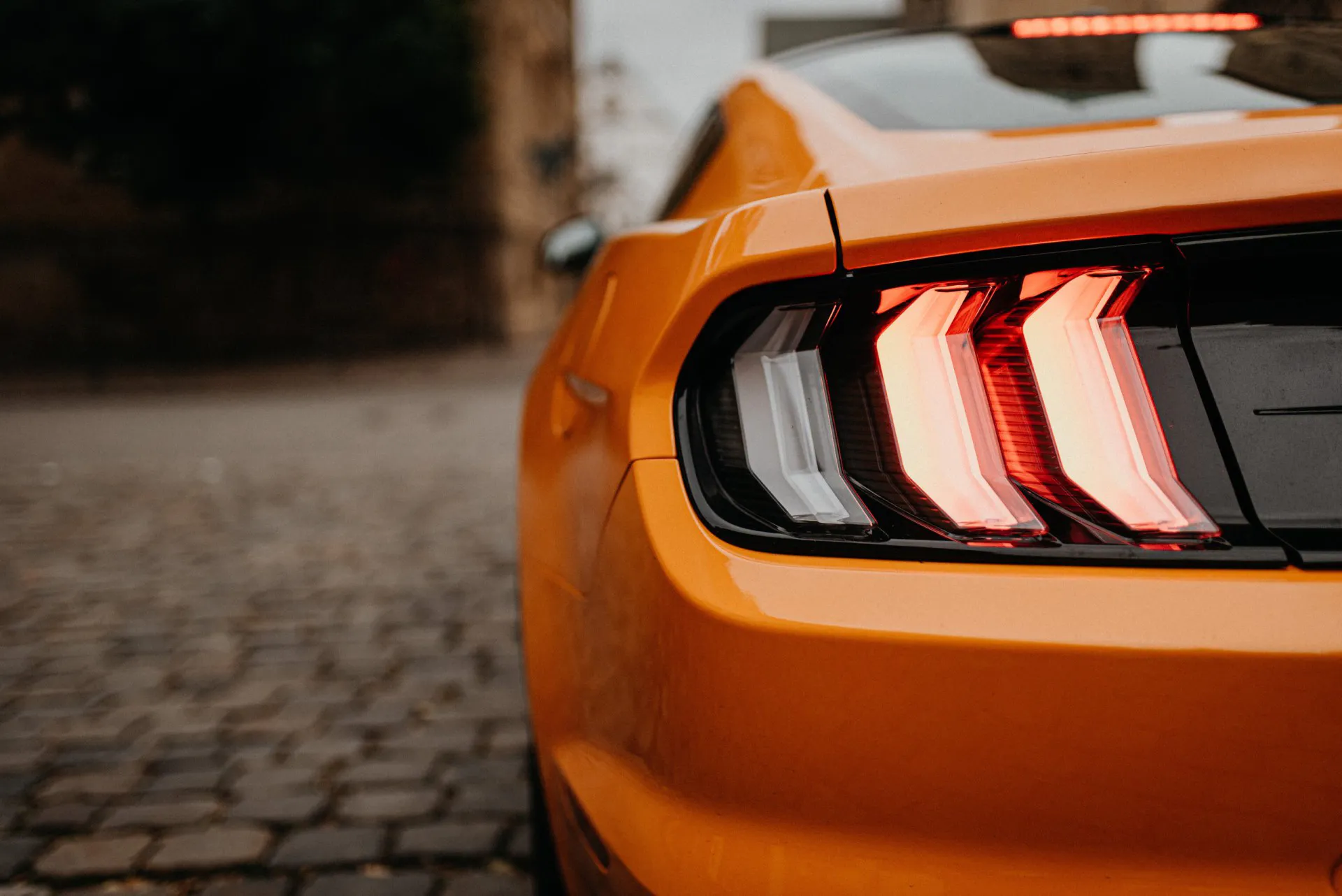
Picking the Ford Mustang model years worthy of a thumbs up comes from a thorough review of FIXD Reliability Scores, Owner Reliability Scores, NHTSA crash test rankings, and EPA fuel economy. In addition, we add common diagnostic trouble codes (DTCs) and NHTSA recall information to the mix.
2018-2020 Ford Mustang
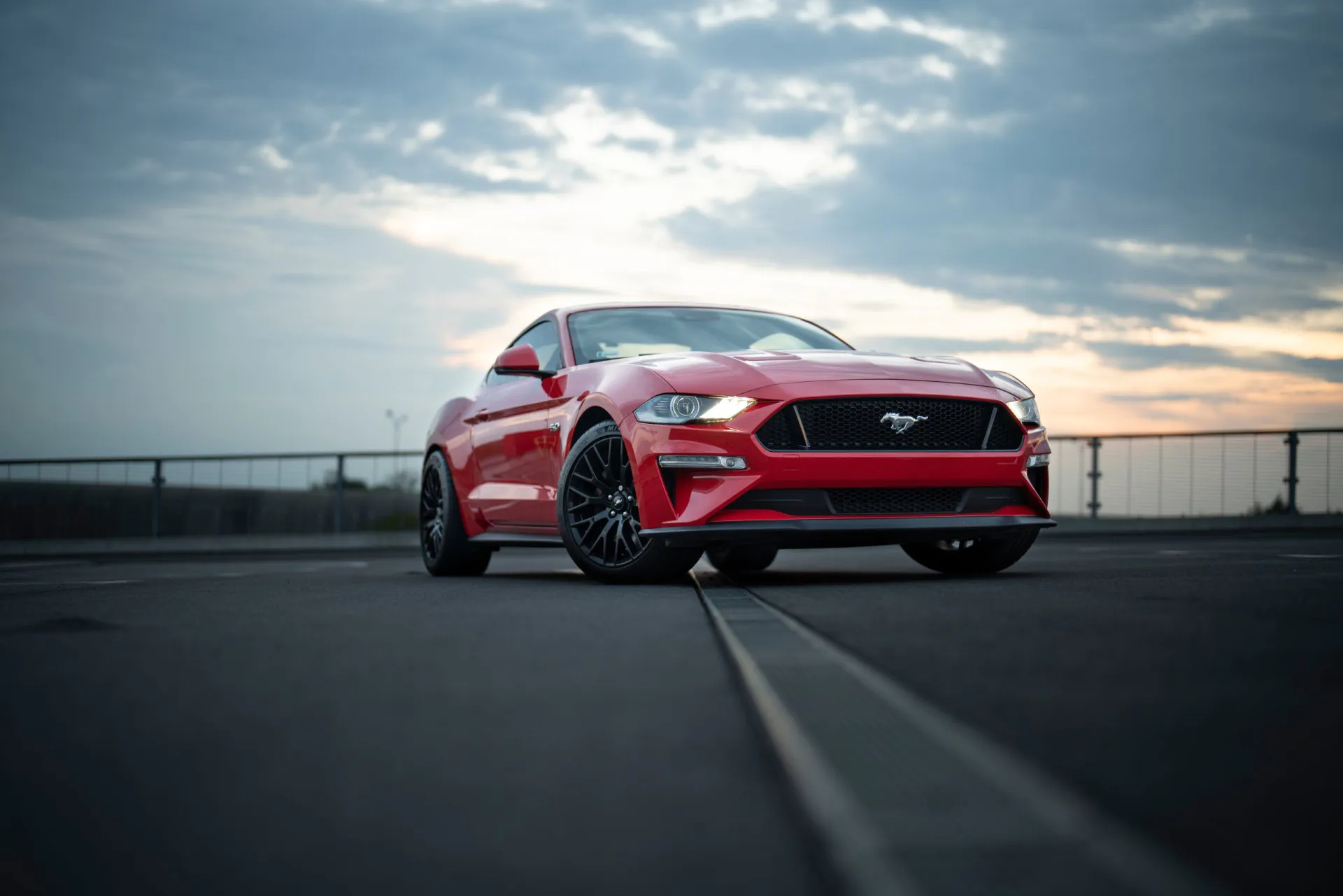
FIXD Reliability Score: 1-8/10
Owner Reliability Score: 9-10/10
KBB Value: $20,413-$27,176
Fuel Economy: 21 MPG
Average Annual Maintenance/Repair: $250-$750
Average Likelihood of a $500+ Repair in 2022: 100%
Safety Rating: 5.0/5
Don’t be put off by a low FIXD Reliability Score (the 2018 and 2019 Mustang ranked a 1 and a 4 out of 10, respectively). Other factors make these cars strong candidates for the best Mustang model years. At the same time, the 2020 Mustang gets high marks with an 8 for its FIXD Reliability Score.
These mixed results are outweighed or supported by a perfect 10 (out of 10) Owner Reliability Score for all three model years. This goes hand-in-hand with the 35% of surveyed owners who rely on these Mustangs for “lots of driving” (traveling and commuting).
Of course, confident owners and new vehicles are how things are supposed to work, but there are additional factors that make a case for these Mustangs.
Let’s start with NHTSA crash test results and another top-notch score (5.0 out of 5). Meanwhile, an average fuel economy rating of 21 MPG makes these model years among the most gas-efficient Mustangs ever made.
Recalls, a fact of life with modern automobiles, are present with the 2018-2020 Mustangs, but not at the level of some older models. The 2018 and 2019 Mustangs are subject to three recalls, while the 2020 edition has five recalls.
Meanwhile, none of the surveyed owners of these Mustangs reported an expensive ($500+) repair involving the engine or transmission during the past year. That’s just as it should be, given the newness of these vehicles. However, we have encountered this issue with other makes and models, which almost automatically puts that specific car on the worst list. This isn’t the case with the 2018-2020 Mustang.
Owners of these Mustangs have spent more than $500 on keeping their cars roadworthy. These expenses are associated with upkeep (brakes, tires, etc.) rather than repairs. A low average of $450 in yearly repair and maintenance expenses is also well below the $697 average for all modern Mustangs and is particularly noteworthy.
At the same time, DTC error codes are present among 2018-2020 Mustangs, which accounts for the low FIXD Reliability Scores for the 2018-2019 editions.
Most significantly, code P0300 appears, which signals an engine misfire, a possibly serious problem. Repairs can be as simple as replacing the spark plugs (cost: $58-$167) or the fuel pressure sensor (cost: $50-$150). However, a new catalytic converter (cost: $1,538-$2,041) is necessary in more extreme cases. A related code, P0303, also deals with engine misfires and similar remedies. Replacing a catalytic converter in newer vehicles is unusual but not unheard of. Cheap gas, improper maintenance, and ignoring early warning signs can lead to this situation.
And speaking of catalytic converters, these Mustang are prone to code P0420 (catalyst system efficiency below threshold—Bank 1). In addition to replacing the converter, fixes can include a new air fuel sensor (cost: $200-$300), replacing the oxygen sensor (cost: $275-$500), or fixing a leaking exhaust (cost: $100-$200).
Buyers of a 2018-2020 Ford Mustang can expect to pay $22,000 to $50,000, depending on the year and equipment. And prices can rise to six figures for a Shelby GT350 or Shelby GT500. The cited KBB value covers private-party transactions; retail pricing is always higher. If the budget allows, the 2020 model year is our pick for a used Mustang.
Another positive for this Mustang “herd” is that many are available through Ford’s certified pre-owned (CPO) program. You’ll pay a premium for this, but you’ll get an extra year or 12,000 miles of bumper-to-bumper coverage and up to seven years or 100,000 miles (from the initial service date) of powertrain protection.
2007 Ford Mustang
FIXD Reliability Score: 1/10
Owner Reliability Score: 8/10
KBB Value: $5,832
Fuel Economy: 18 MPG
Average Annual Maintenance/Repair: $646
Average Likelihood of a $500+ Repair in 2022: 100%
Safety Rating: 4.8/5
The 2007 Ford Mustang is another example of a car that’s more than just a low FIXD Reliability Score. Indeed, a rating of 1 (out of 10) should be viewed cautiously. However, a high Owner Reliability Score (8 out of 10) counterbalances this quite well. Interestingly, 41% of surveyed owners of a 2007 Mustang report using their cars for traveling and commuting. That’s a high number, especially considering the age of the vehicle.
This confidence is supported by average annual repair and maintenance costs ($646) and minimal chance of expensive engine and transmission repairs (which we’ll cover shortly).
This Mustang gets more bonus points for impressive crash test results (4.8 out of 5). Remember, this is a vehicle that’s more than 15 years old. And an average 18 MPG fuel economy rating makes fill-ups less painful.
Of course, no car is flawless, including the 2007 Mustang and its nine recalls. Yet, most of these issues involve airbags, which, while a vital system, aren’t related to the car’s mechanical systems.
The 2007 Ford Mustang is also appealing because owners report no expensive repairs related to the engine during the past year. That’s notable because these cars have an average of 108,000 miles. Further, these same reports indicated that only 5.5% of owners shelled out $500 or more for a transmission repair—a particularly modest number of affected Mustangs given age and usage.
DTC codes are also part of the ownership experience with an older vehicle. For the 2007 Mustang, this means P0171, System Too Lean—Bank 1. That’s a technical way of saying the fuel mixture has too much air or not enough gas. While a Mustang owner can drive with this problem, the issue should be fixed immediately to avoid further complications.
The troubles can usually be traced to a vacuum leak, a mass airflow (MAF) sensor that needs cleaning or replacing (cost: $100-$300), or a bad oxygen sensor. More extensive repairs can require a new fuel pump for $1,300-$1,700.
Like code P0171, P0174 deals with the same issues but on Bank 2 of the engine.
Error code P2195 is also common in the 2007 Mustang and relates to a faulty oxygen sensor. Repairs can involve replacing the sensor or dealing with an exhaust or vacuum leak. Sometimes, the fix consists of installing a new fuel pressure regulator ($200-$400). Codes P0300 and P0420, which we’ve covered on newer Mustangs, are known to occur in this Mustang.
With some careful shopping, you’ll be able to find a decent 2007 Mustang for about $15,000 or even less if you don’t need a V8. Of course, low-mileage examples and high-end Shelbys will cost considerably more.
2004 Ford Mustang
FIXD Reliability Score: 1/10
Owner Reliability Score: 8/10
KBB Value: $3,072
Fuel Economy: 19 MPG
Average Annual Maintenance/Repair: $600
Average Likelihood of a $500+ Repair in 2022: 100%
Safety Rating: 4.2/5
We classify the 2004 Ford Mustang as the least-best example to buy. Much of this has to do with age. After all, it’s a 20-year-old sports car with an average of 136,000 miles on the odometer. So it’s reasonable to expect a few dings in the armor, but there are enough positive aspects to make this a worthwhile weekend vehicle or daily runner.
As with some newer model years, the 2004 Mustang ranks at the bottom with a 1 out of 10 in the FIXD Reliability Score. Yet, this is offset by owners giving their Mustangs a solid 8 (the Owner Reliability Score).
And these cars don’t sit in the garage. 42% of surveyed owners report using their Mustangs for sport/fast driving, while 33% rely on their cars for family hauling duties. Meanwhile, 8% like their Mustangs for “luxurious driving,” and another 8% consider this vehicle an office on wheels.
Other favorable characteristics include a below-average annual repair and maintenance bill of $600. When this amount goes far above the model average, it’s usually an indicator to look for a different year. That’s not a worry with the 2004 Mustang, based on survey data. We also like that owners reported no significant engine or transmission repair outlays. Did we say this is a two-decade-old car?
That doesn’t mean a complete absence of pricey service work. In fact, 100% of surveyed owners spent more than $500 on their Mustangs during the last year, but this didn’t include the powertrain. That’s very good. The most likely issue involved the brakes, which is more of a maintenance issue than a repair.
The usual suspects appear as far as DTC error codes: P0171, P0174, and P2195. But there are a few new ones to be aware of. P0455 is common and deals with the evaporative emission control (EVAP) system. Just tightening or replacing the gas cap (about $20) could solve the problem. Although things could escalate to a new valve or EVAP line (cost: $100-$200).
Code P2197 is also known to trigger an error message in the 2004 Mustang. And like P02195, it’s a signal about an oxygen sensor. So repairs can involve everything from vacuum or exhaust leaks to replacing the oxygen sensor or fuel pump.
It’s also helpful to know that the 2004 Ford Mustang has been recalled six times.
Lastly, this Mustang has great appeal because of its price as a used car. Finding an example for under $10,000 is certainly possible. And who knows, it could even be a convertible.
The Worst Years of the Ford Mustang
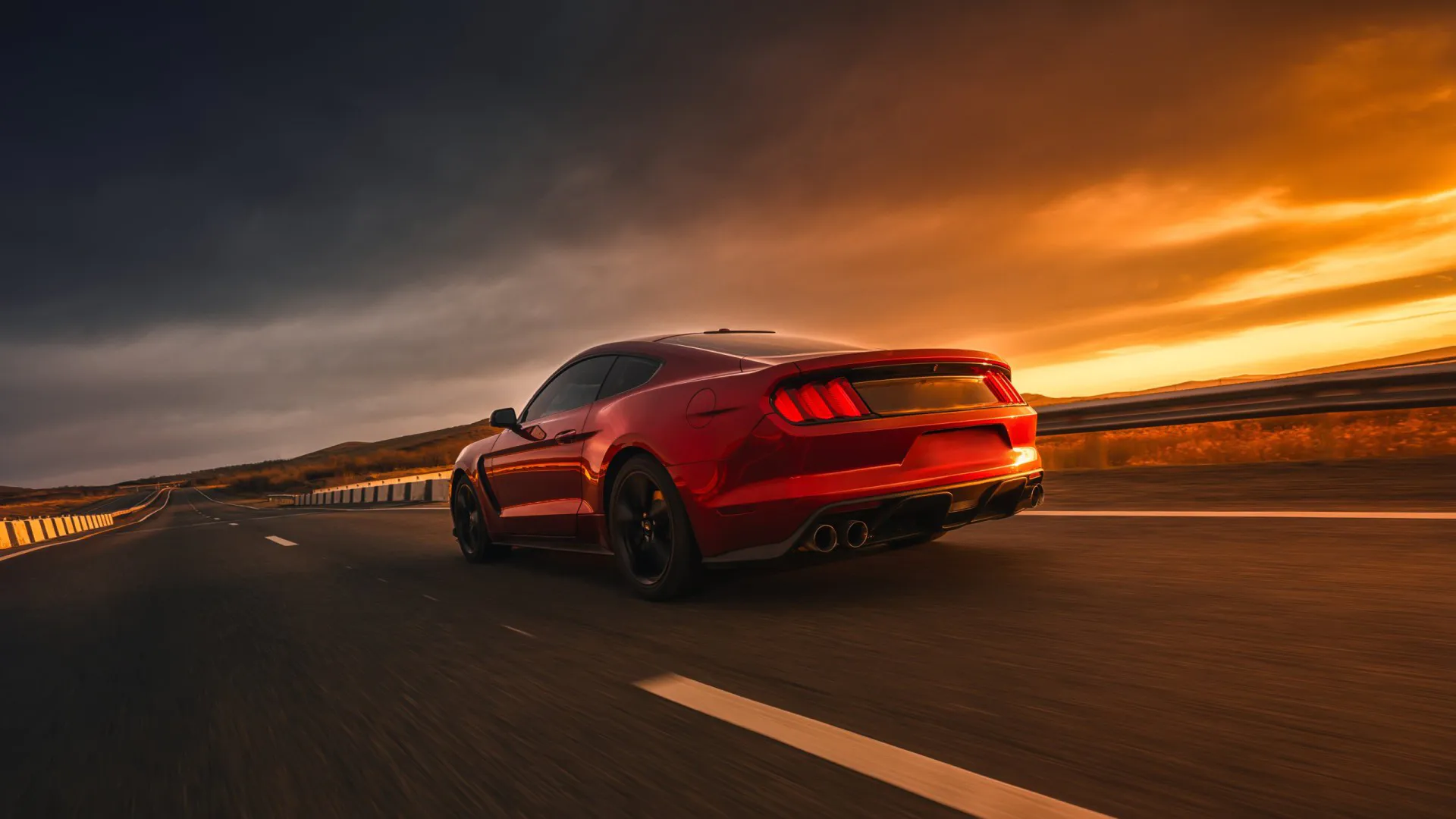
Unfortunately for Mustang lovers, there are more bad model years than good ones. These are the Mustangs to avoid, due to low-ranking combinations of FIXD Reliability and Owner Reliability Scores, high repair costs, and other factors.
2015-2016 Ford Mustang
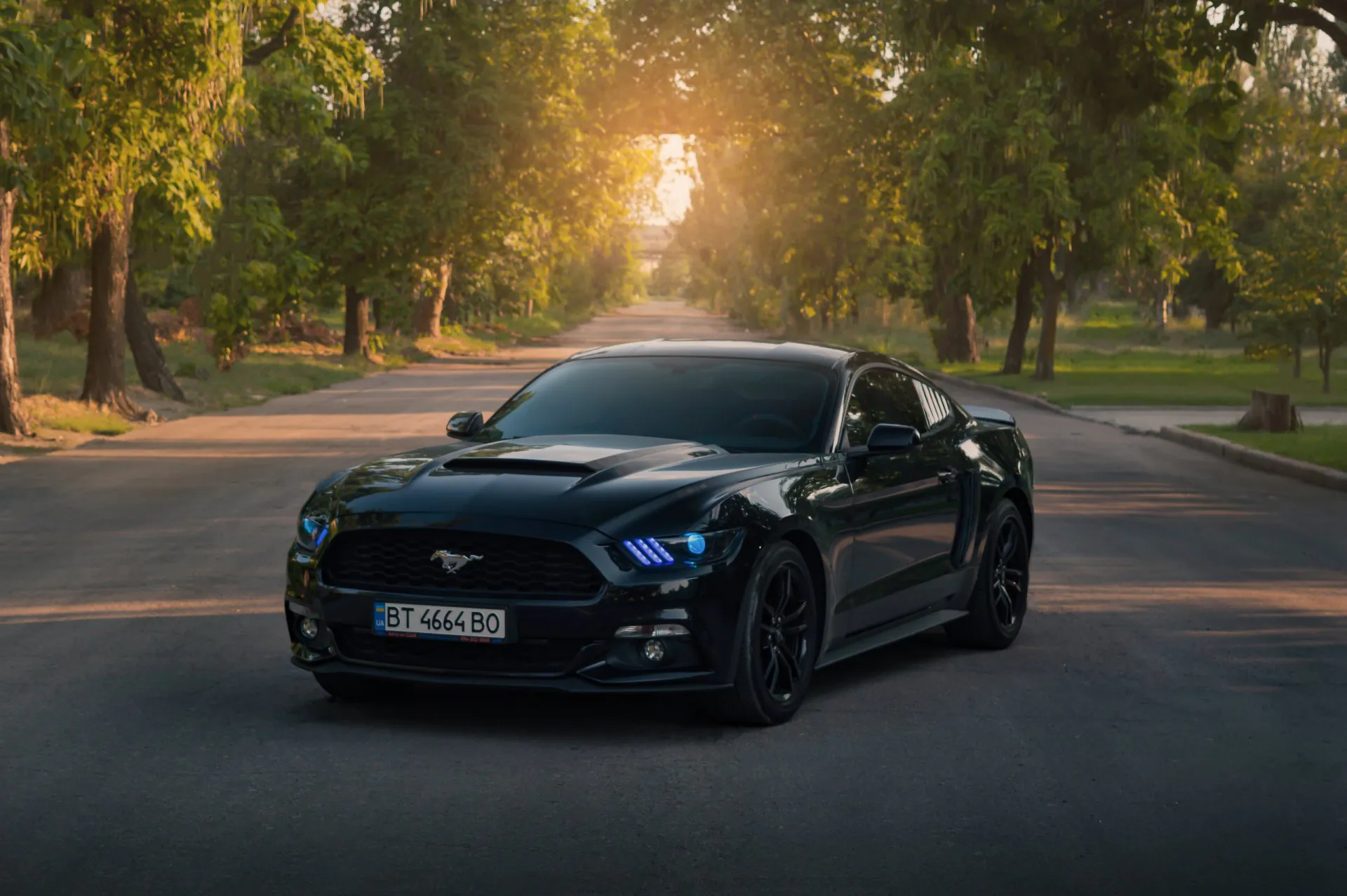
FIXD Reliability Score: 4-8/10
Owner Reliability Score: 8/10
KBB Value: $11,574-$15,459
Fuel Economy: 21-22 MPG
Average Annual Maintenance/Repair: $574-$607
Average Likelihood of a $500+ Repair in 2022: 85%-100%
Safety Rating: 4.8/5
The Mustangs from the 2015-2016 model years appear to be a reasonable used car choice, but let’s explore why they’re not. The 2015 model year is the debut of the sixth-generation (S550) Mustang. We typically advise staying away from the first year of an all-new car to avoid those initial gremlins. This is the same recommendation we make for other Fords, like the F-150, and different brands, such as Chevrolet and Honda.
The S550 is substantially different from its fifth-generation (S197) predecessor. This is evidenced by nine recalls for the 2015 Ford Mustang, higher than most other years from the 21st century. This increase is a warning sign.
While there are only three recalls for the 2016 Mustang, other reasons exist to avoid this Ford. This includes a sub-par FIXD Reliability Score of 4 (the 2015 Mustang had the same rating), which shouldn’t be an issue for a newish vehicle.
Additionally, there are multiple instances of 2016 Mustang owners spending more than $500 to repair the engine or transmission. Again, something that shouldn’t be happening on newer cars.
At least these Mustangs have below-average annual spending ($591) for upkeep (maintenance and repairs). Average fuel economy of 21-22 MPG and strong crash test scores (4.8) are also appealing. But, an elevated chance of expensive repairs is a key reason to stay away from this Mustang grouping.
If that’s not enough to convince you, consider that among all of the Mustangs with the FIXD sensor, the 2015 model year has the highest incidents of error codes P0300 and P0303 (for engine misfires). The codes also appear in the 2016 Mustang.
Meanwhile, potentially expensive-to-fix codes P0420 and P0430 (a faulty catalytic converter—problems similar to P0420 ) are common in these Mustangs. Replacing a catalytic converter typically costs $1,538-$2,041.
2005-2006, 2008, and 2010-2014 Ford Mustang
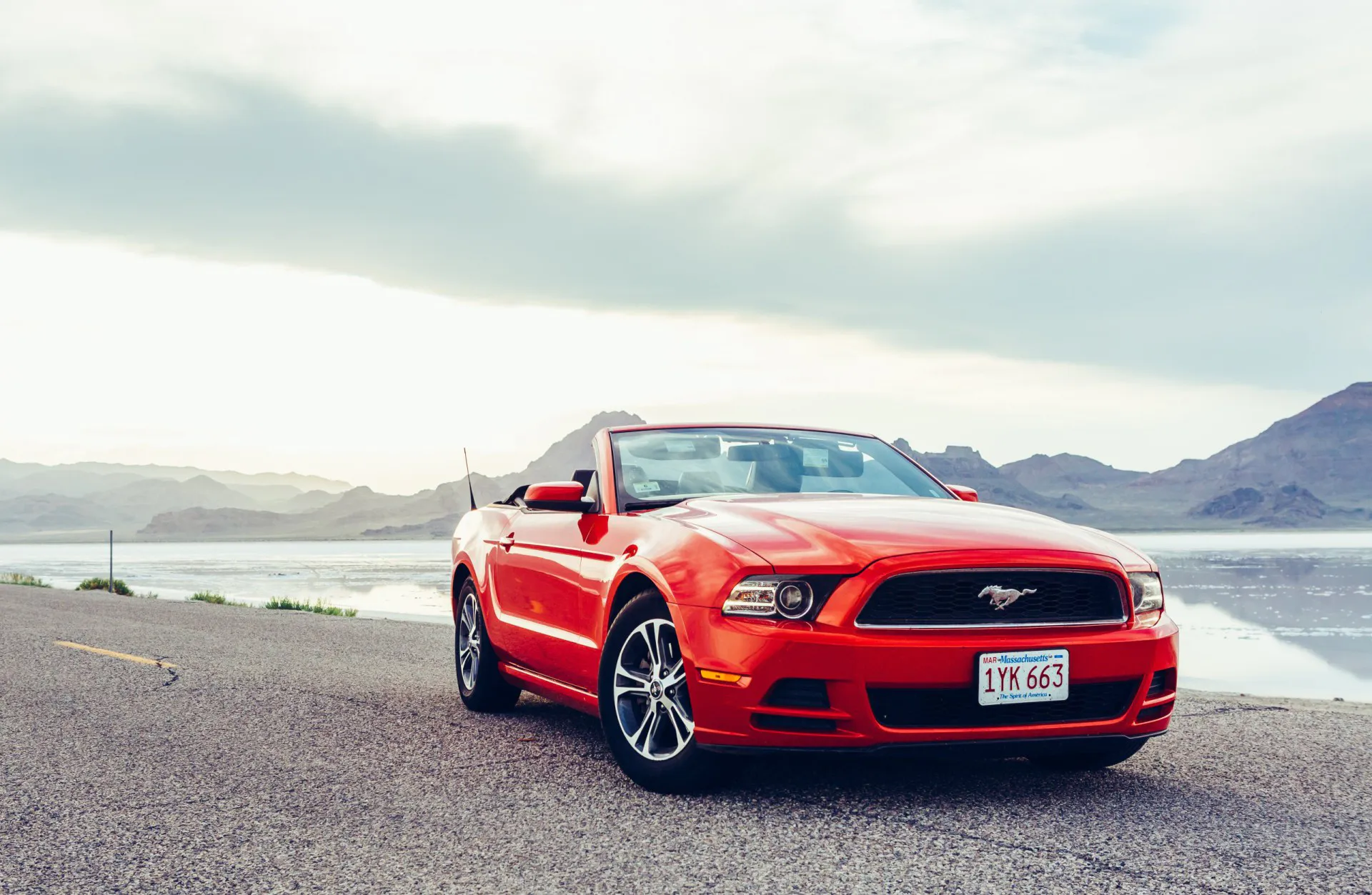
FIXD Reliability Score: 1-4/10
Owner Reliability Score: 7-10/10
KBB Value: $4,076-$13,332
Fuel Economy: 18-21 MPG
Average Annual Maintenance/Repair: $574-$607
Average Likelihood of a $500+ Repair in 2022: 70%-100%
Safety Rating: 4.8/5
Our apologies if you’re a fan of the S197 Mustang. We’ve gutted the fifth generation, except for the 2007 and 2009 model years, which are assigned to the Best and Undecided categories, respectively. Let’s explain the reasons for the poor grades.
Certainly, most S197 years getting a FIXD Reliability Score of 1 doesn’t help. But, as we’ve shown with other Mustang model years, a low rating here doesn’t automatically push a car into the worst category. It’s piling on the other bad factors that prove the ultimate undoing for this Mustang grouping.
Let’s first look at recalls. The 2005 and 2006 model years have ten recalls each. That makes them the most recalled Mustangs of the 21st century. It gets slightly better for the 2008 Mustang with nine recalls. At least the recalls decline in the later years of the fifth-generation Mustang (2010, 2011, 2012, 2013, and 2014), but this works out to 4-7 recalls per year.
Yearly upkeep for the 2005-2006 Mustangs is at least 35% higher than the $697 that the average Mustang owner spends for repairs and maintenance. Plus, there’s a high likelihood of expensive engine or transmission work for this entire group. 20% of surveyed 2013 Mustang owners reported spending at least $500 to fix the transmission. It’s even worse for some other Mustang owners. An eye-popping 28.5% of those with a 2010 model spent similar money to fix the engine and 21% for owners with a 2012 Mustang.
Overall, 2005-2006, 2008, and 2010-2014 Ford Mustang have an unacceptably high risk of needing pricey engine and transmission work.
But it doesn’t stop there. Across this Mustang range, there are hundreds of error code reports for P0171, P0174, and P0300 (with the 2005-2006 editions leading the pack). These codes are all problems that have plagued other Mustang model years.
This is also an excellent time to mention why different Mustang model years share the same DTC codes. Mustang generations tend to have more model years than other cars (the typical new car cycle is five years). In other words, Ford waits longer to redesign the Mustang (up to ten years or more). This means parts get carried over to new model years and sometimes even to new generations. So the inherent weaknesses of these components become a problem with subsequent Mustangs.
2001-2003 Ford Mustang
FIXD Reliability Score: 1/10
Owner Reliability Score: 4-7/10
KBB Value: $2,394-$2,979
Fuel Economy: 19-20 MPG
Average Annual Maintenance/Repair: $781-$1,100
Average Likelihood of a $500+ Repair in 2022: 75%-89%
Safety Rating: 2.5-4.0/5
The expression, “You get what you pay for,” has significant meaning for the 2002-2003 Ford Mustang. Getting an older Mustang for about $5,000 sounds like a bargain until the repair and maintenance bills appear. And this includes looking past a FIXD Reliability Score of 1 for all three years.
And we’re not neglecting the 4.0 (out of 10) that the 2001 Mustang received for the Owner Reliability Score. It’s the lowest-ranking 21st-century Mustang in this area. No other modern Mustang received a score below 7. That’s a big red flag.
With an average yearly upkeep expense of $1,100, the 2001-2002 Mustangs are the most expensive to maintain and repair. And the 2003 isn’t cheap either with $781 in annual costs.
And the bad news continues. Over the past year, about 19% of 2001-2002 Mustang owners had to spend $500 or more to keep the engines running. And even though the odds of expensive engine repairs got cut in half for the 2003 model year, that still means one in ten owners encountered (and paid for) this problem.
It comes as no surprise that there are many DTC codes with the 2001-2003 Mustang, including ones we’ve already covered, like P0171, P0174, and P0430. However, P0133 (a faulty oxygen sensor) arises with curious frequency in the 2002 Mustang (more so than all other model years combined). Fortunately, it’s only moderate-level trouble, but it usually means paying for a new oxygen sensor.
The 2001 Mustang has eight recalls, while there are six recalls each for the 2002 and 2003 Mustang, which puts these model years in the middle of the pack in this area. These cars do shine in the MPG department (19-20 MPG), but that doesn’t make up for terrible safety scores. Both years received a 2.5 (out of 5) in NHTSA crash tests, the worst of any modern Mustang and arguably a significant reason to buy a different Mustang model year. For the record, the 2001 Mustang received a 4.0.
Undecided Years of the Ford Mustang
We understand that it’s helpful to have clear guidance about which Ford Mustang years to buy and which ones to avoid. Yet, providing black-and-white answers isn’t always possible. As mentioned, we don’t attach a “best” or “worst” label solely on a FIXD Reliability Score.
Another key element of this formula is owner feedback via a detailed survey. When we don’t receive a sufficient number of these individual assessments, it’s challenging to get a complete picture.
That’s the case with a few Mustang model years (2009, 2017, and 2019). So, rather than leave these cars out of the results, we’re giving them an “Undecided” designation. Basically, they’re in “limbo” until more feedback becomes available.
In the meantime, here’s a summary of these Mustang model years. You can decide on your own if these cars are worthy contenders.
2009 Ford Mustang
FIXD Reliability Score: 1/10
KBB Value: $10,661
Fuel Economy: 18 MPG
Safety Rating: 5.0/5
On the surface, the 2009 Mustang doesn’t have much going for it. A FIXD Reliability Score of 1 is as bad as it gets. And the surrounding model years (2008 and 2010-2014) are on the worst list. Let’s also note that the 2009 Mustang also has seven recalls.
Yet there are glimmers of hope for this fifth-generation Mustang. Notably, there are fewer DTC codes (dozens of instances, not hundreds)—which is encouraging. You know the ones: P0171, P0174, P0300, P0420, and P0430 (All of these were mentioned earlier in the article. And a perfect NHTSA crash test score (5.0) is always a plus. Fuel economy at 18 MPG is respectable, too.
But, the lack of information about owner reliability perceptions, upkeep costs, and major repairs prevents a thumbs up or thumbs down. A 2009 Mustang could be a hidden gem or a nightmare waiting for a new owner.
We’ll just advise that if you’re considering buying a 2009 Mustang, have it (or any prospective used car) thoroughly inspected by a professional mechanic before signing the paperwork.
2017, 2021 Ford Mustang
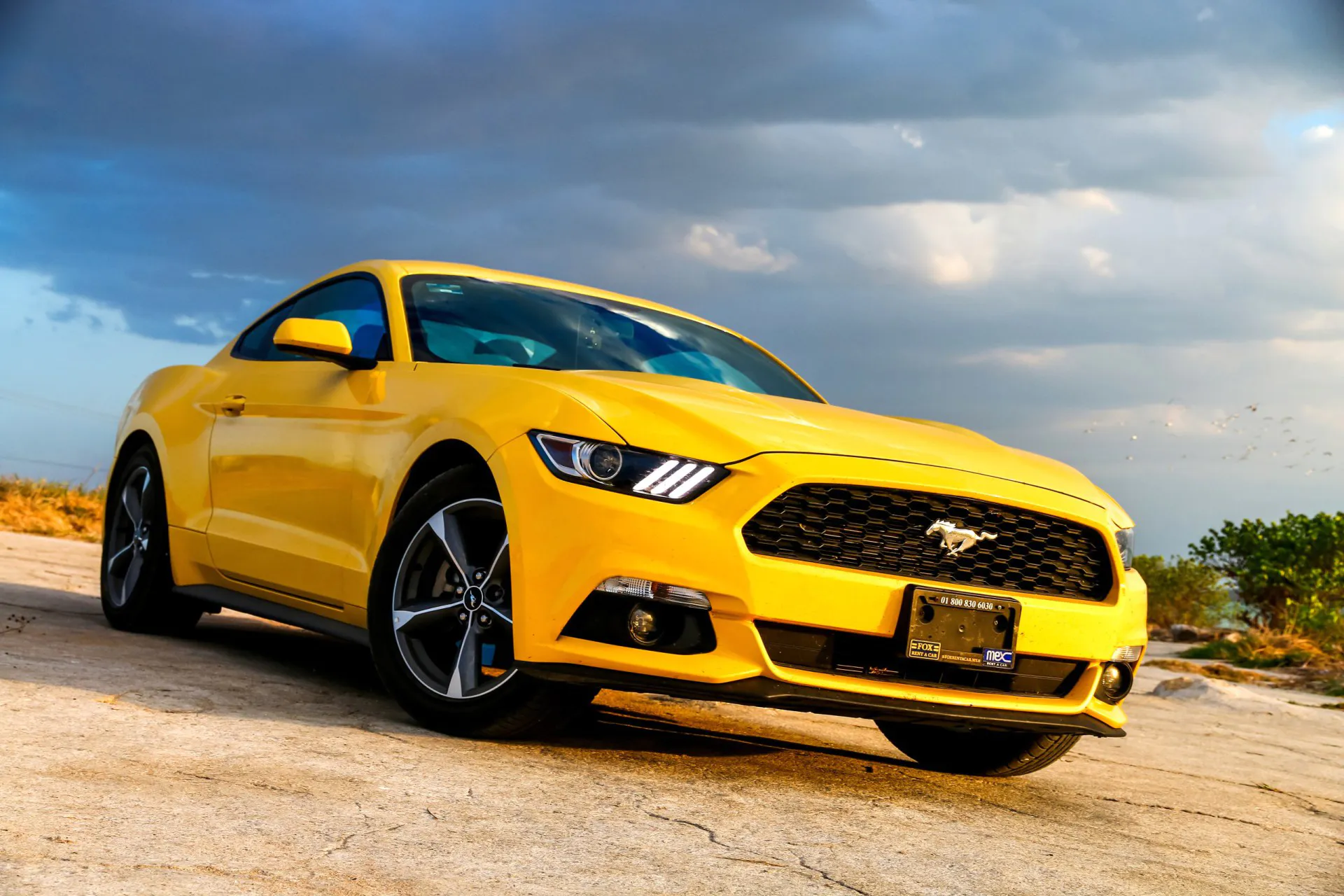
FIXD Reliability Score: 7-8/10
KBB Value: $14,953-$27,176
Fuel Economy: 21 MPG
Safety Rating: 4.8-5.0/5
There’s a lot to like about the 2017 and 2021 Ford Mustang, members of the sixth generation. For instance, the 2017 Mustang gets a FIXD Reliability Score of 7, a significant improvement from the 4 that the 2015-2016 Mustangs received. And the 2021 model year is even better, with a worthy 8 for this index.
Fuel economy at 21 MPG is among the best for all modern Mustangs, and safety scores of 4.8 for the 2017 and 5.0 for the 2021 are more than commendable. Even the recalls are modest; four for the 2017 Mustang and two for the 2021 model year.
But these strong points don’t overcome the unknown. There isn’t sufficient data to tell us about yearly upkeep expenses or if the engine or transmission is troublesome (meaning expensive to fix). For instance, 13% of owners of the 2016 model year spent more than $500 in the past year on engine work. Is the 2017 model year better or worse? The 2017 Mustang also has a high occurrence (200+ incidents) of DTC code P0420.
The jury is still out on both the 2017 and 2021 Mustangs.
A Note About The 2022-2023 Ford Mustang: A lack of meaningful data prevents the final years of the sixth-generation Mustang from appearing on our best and worst year overview. Updates will be made as information becomes available, including on the 2024 Ford Mustang, the first model year of the seventh (S650) generation.
FAQs
What years of the Ford Mustang have engine and/or transmission problems?
2001, 2002, 2010, and 2012 are the Ford Mustang model years with the greatest chance of needing engine repairs of $500 or more. Further, the 2006 and 2013 Mustangs have an increased chance of needing costly transmission repairs.
What is considered high mileage for a Ford Mustang?
A high-mileage designation for a Ford Mustang means different things to different people. Someone who drives a Mustang as a weekend-only cruiser might not be so concerned if their car has 95,000, the average mileage among all Mustangs (based on owner surveys). However, someone who depends on their Mustang for commuting and long trips might think otherwise.
We’ll use that average figure (95,000 miles) as the high-mileage threshold for the Mustang. This is also based on surveys showing the highest average mileage is 145,000 miles (for the 2001 model year), suggesting a possible upper limit for the Mustang.
Are there Mustangs with 200,000 miles? Most likely, yes. Such longevity comes from thoughtful driving and diligent maintenance. Conversely, some Mustangs with half this usage are on their last legs, with negligent driving and poor upkeep to blame.
Ultimately, a high-mileage label comes from a qualified mechanic who can assess a Mustang’s condition and potential for continued use.
Any model year on our best list will do for those seeking a Mustang for casual use. Even the older model years have some life left (the average mileage for a 2007 Mustang is 108,000 miles). But, those looking for a daily driver with longevity will want a newer model. The 2018-2020 Mustangs have an average of 38,000 miles.
What other vehicles should I consider?
The Mustang occupies a unique position in Ford’s current lineup. It’s the only passenger vehicle among many SUVs and trucks. If you want a different Ford passenger car, you’ll have to turn to the used car market for a Ford Focus, Ford Fusion, or one of the other sedans, hatchbacks, station wagons, and coupes that the Blue Oval has made over the years.
Outside of Ford, the Chevrolet Camaro and Dodge Challenger are direct competitors to the Mustang. Although a four-door, the Dodge Charger provides a sedan alternative to the Ford Mustang.
What owners of the Ford Mustang like to use their car for:
| Frequent Use Categories: | How Useful? (Out of 5 Stars) |
| Sport/Fast Driving | **** |
| Lots of Driving (travel/long commute) | *** |
| Family Vehicle | *** |
| Luxurious Driving | ** |
| Office on Wheels | * |
| Hauling/Towing | * |
| Outdoor/Off-Road | * |
A Note About Data and Information Sources
This article has many details about Ford Mustang reliability; here’s what we used for our assumptions and recommendations.
- FIXD Reliability Score & Data: Engine reliability information is captured via the FIXD App.
The FIXD Reliability Score is calculated using the number of DTCs per year, weighted by mileage. This is then turned into a scale of 1-10 for easy graphing.
This is an objective score.
- Owner Reliability Score & Data: This data is the result of surveying Ford Mustang owners who use FIXD.
The Owner Reliability Score comes straight from owners of the Ford Mustang.
This is a subjective score.
To determine the Owner Reliability Score, we ask each car owner:
How reliable would you say your Ford Mustang is?
a. Just point A to point B driving
b. A Daily Commuter
c. Good for a 100-mile road trip
d. Good for a 500-mile road trip
e. I could take a cross-country road trip, no problem
From here, we translate their answers into the Owner Reliability Score:
a. = 2
b. = 4
c. = 6
d. = 8
e. = 10
Keep in mind owners may think their car is more or less reliable than it actually is.
One potential problem is that people often buy the same make or model they are used to when they go car shopping, just a newer year.
Ford, for instance, has a number of consumer loyalty awards for the Ford F-Series, Ford Mustang, and Ford Expedition.
Car owners may be so loyal to the make or model they currently own that they would have trouble accurately comparing their cars’ reliability to others.
It’s for this reason that we ask car owners a question that is relative to mileage rather than relative to other cars.
Still, be mindful of the accuracy of these Owner Reliability Scores; people’s perceptions and unconscious blindspots can skew data.
We suggest looking at both the FIXD Reliability Score and the Owner Reliability Score for this reason.
- KBB Value: Average private-seller valuations as supplied by Kelley Blue Book (KBB), based on a Ford Mustang with typical mileage for that respective model year.
- Fuel Economy: Mileage-per-gallon estimates according to the EPA MPG on Fueleconomy.gov
- Annual Maintenance/Repair: Upkeep expenses as reported by surveyed Ford Mustang owners
- Safety Rating: Crash test data collected and reported by NHTSA. We average all ratings for each year to come up with a simplified, average safety score. This makes it easier to look at on a graph.
References
- Ford Mustang model-specific information, edmunds.com (various dates). Retrieved May 11, 2023, from https://www.edmunds.com/
- Model-specific recall information as per the National Highway Transportation Safety Administration. Retrieved May 11, 2023, from https://www.nhtsa.gov/recalls
- Ford Gold Certified Information. Retrieved May 11, 2023, from https://www.ford.com/used/about-certified/gold-certification/

Dave Goldberg is an automotive journalist and lifelong car fanatic. He writes for numerous enthusiast and business outlets and is an ongoing contributor to HotCars.com, one of the most popular car culture websites. When he’s not writing or driving, Dave is either under a hood or asleep. His credentials include a BA in Journalism from The George Washington University.

